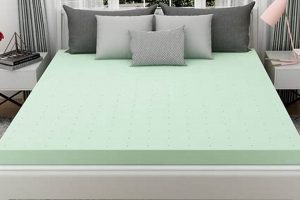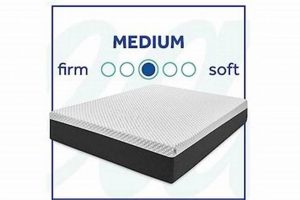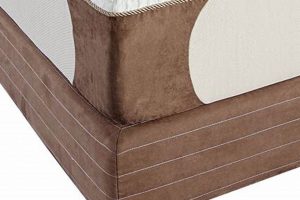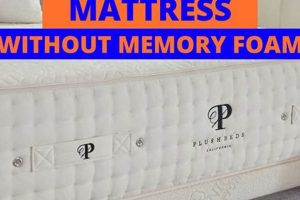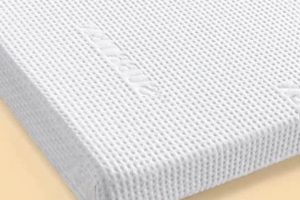Moving a large and often unwieldy sleeping surface composed of viscoelastic polyurethane foam presents unique challenges. This task requires careful planning and execution to prevent damage to the item itself, the surrounding environment, and the individuals involved. A compressed material, though conforming, retains significant weight and bulk, requiring strategic handling during relocation.
Proper handling of this furniture is essential for maintaining its structural integrity and prolonging its lifespan. Failure to adequately protect and support it during transit can lead to tears, compressions, or permanent deformities, negating its comfort and support benefits. Furthermore, improper lifting techniques can result in personal injury, emphasizing the need for a methodical and safe approach. This type of furniture has become increasingly prevalent in homes due to its perceived comfort and support advantages.
The subsequent sections will detail specific steps involved, including preparation through securing the item, employing proper lifting techniques, navigating tight spaces, and ensuring safe transportation to a new location. Consideration will be given to both the equipment necessary and the appropriate manpower required for successful completion of the task.
Relocation Strategies
The following guidance facilitates the successful transportation of the mattress while minimizing the risk of damage or injury. Adhering to these recommendations ensures a more efficient and secure process.
Tip 1: Protective Encapsulation: Before commencing movement, encase the item in a durable mattress bag. This prevents dirt, moisture, and potential tears during handling and transit. Secure the opening with packing tape to ensure a complete seal.
Tip 2: Strategic Lifting Technique: Employ the lift with your legs method, maintaining a straight back to avoid strain. Coordinate movements with all participants to ensure a synchronized and controlled lift. Avoid twisting or jerking motions.
Tip 3: Optimal Grip Points: When lifting, maintain a firm grip on the mattress. Distribute weight evenly to prevent imbalances that could lead to accidental dropping or shifting.
Tip 4: Route Assessment and Clearance: Prior to commencing the move, thoroughly assess the intended path. Clear any obstacles, such as furniture, boxes, or protruding objects, that could impede progress or pose a safety hazard.
Tip 5: Doorway Navigation: When maneuvering through doorways, consider tilting the item on its side to reduce its width. Employ padding around the edges to prevent scraping or damage to the door frame and mattress.
Tip 6: Secure Transportation: If transporting the item in a vehicle, ensure it is adequately secured to prevent shifting during transit. Use straps or ropes to tie it down firmly, minimizing the risk of movement that could cause damage.
Tip 7: Professional Assistance: For individuals unable to lift or handle heavy objects, or when dealing with limited space or challenging environments, consider engaging professional moving services. These professionals possess the equipment and expertise to safely and efficiently relocate the item.
Following these guidelines minimizes the potential for damage and personal injury during the relocation process. These procedures represent a proactive approach to ensuring a secure and efficient transfer.
The concluding section will summarize the key elements of preparation, handling, and transportation, emphasizing the importance of a coordinated effort for a successful outcome.
1. Preparation Prevents Damage
In the context of relocating a memory foam mattress, thorough preparation significantly reduces the likelihood of damage. This proactive approach encompasses various steps, each designed to mitigate specific risks associated with the moving process.
- Protective Packaging
Employing a durable mattress bag or wrap forms a critical first line of defense. This barrier safeguards the mattress against dirt, moisture, and abrasions encountered during handling and transit. Failure to adequately protect the surface can result in cosmetic damage or, more severely, compromise the foam’s integrity.
- Route Planning and Obstacle Mitigation
A pre-emptive assessment of the moving route identifies potential hazards such as narrow doorways, sharp corners, or uneven surfaces. Addressing these challenges in advance, through adjustments or removal of obstacles, minimizes the risk of accidental impacts and subsequent damage to the mattress or surrounding structures.
- Necessary Equipment Acquisition
Ensuring the availability of essential equipment, such as dollies, furniture straps, and moving blankets, facilitates a more controlled and secure relocation. The absence of appropriate tools can lead to improvised methods, which often increase the potential for mishandling and damage.
- Manpower and Coordination
Adequate manpower and clear communication among participants are essential for safe and efficient movement. Attempting to handle a heavy or unwieldy mattress with insufficient assistance increases the risk of dropping or dragging, resulting in damage to the item or potential injury to individuals involved. Clear communication and coordinated movements minimize these risks.
These preparatory measures, when diligently implemented, contribute to a significantly reduced risk of damage during the relocation of a memory foam mattress. The investment in careful planning and execution translates directly into the preservation of the mattress’s condition and the prevention of unnecessary expenses related to repair or replacement.
2. Protective Mattress Encapsulation
Protective mattress encapsulation is a critical element in the process of relocating a memory foam mattress. It serves as a primary defense against various potential damages and contaminants that can arise during movement and transportation. The effectiveness of this step significantly influences the condition of the mattress upon arrival at its destination.
- Prevention of Physical Damage
A mattress bag or wrap prevents tears, punctures, and abrasions that can occur when moving the mattress through doorways, hallways, and into transport vehicles. Sharp corners, protruding objects, or rough surfaces pose threats that are effectively mitigated by a protective layer. For example, dragging a mattress without encapsulation across a concrete floor could result in significant tearing of the fabric and underlying foam.
- Protection Against Soiling and Staining
During transit, a mattress can be exposed to
dirt, dust, and other contaminants that can permanently soil or stain the fabric. Encapsulation provides a barrier against these elements, preserving the cleanliness and aesthetic appeal of the mattress. Without this protection, spills, tracked-in dirt, or even airborne dust can penetrate the fabric, necessitating professional cleaning or, in severe cases, rendering the mattress unusable. - Safeguarding Against Moisture Intrusion
Exposure to moisture during relocation can lead to mold growth and mildew, which can compromise the hygiene and structural integrity of the memory foam. Encapsulation, particularly with a waterproof or water-resistant material, protects the mattress from rain, spills, or damp conditions encountered during transit or storage. For instance, leaving a mattress exposed to rain in the back of a truck could lead to significant water damage if it isn’t protected.
- Facilitating Easier Handling
A properly encapsulated mattress is easier to grip and maneuver. The smooth, uniform surface provided by the bag or wrap allows for a more secure hold, reducing the risk of dropping the mattress during lifting and transportation. This enhanced grip is particularly beneficial when navigating stairs, tight corners, or other challenging spaces.
In summary, protective mattress encapsulation serves as a fundamental component in ensuring the safe and efficient transportation of a memory foam mattress. It provides a critical barrier against physical damage, soiling, moisture, and other potential hazards encountered during the relocation process. Utilizing quality protective measures directly correlates with preserving the condition and longevity of the mattress.
3. Safe Lifting Techniques
The application of safe lifting techniques is paramount when addressing the complexities of relocating a memory foam mattress. The weight and size of these items present a significant risk of injury if improper methods are employed. Adherence to established protocols is crucial for mitigating potential harm.
- Proper Body Mechanics
Maintaining proper body mechanics involves bending at the knees rather than the waist, keeping the back straight, and holding the item close to the body. These principles distribute the load across stronger muscle groups and minimize strain on the spine. For instance, attempting to lift a mattress by bending forward at the waist places excessive pressure on the lower back, increasing the risk of muscle sprains or disc injuries.
- Coordinated Movement
When multiple individuals are involved, synchronized lifting and carrying are essential. All participants must communicate effectively and move in unison to maintain balance and avoid sudden shifts in weight. A lack of coordination can lead to uneven weight distribution, increasing the risk of dropping the mattress or causing injury to one or more individuals involved.
- Controlled Pace and Route Awareness
Maintaining a controlled pace and being aware of the surrounding environment are crucial safety considerations. Rushing or navigating obstacles without caution increases the risk of tripping, slipping, or colliding with objects. A measured approach and a clear understanding of the intended path minimize these potential hazards.
- Use of Assistive Devices
Employing assistive devices such as dollies or furniture straps can significantly reduce the physical strain associated with moving a mattress. These tools distribute the weight and provide leverage, making the task more manageable and safer. Attempting to carry a heavy mattress without assistive devices, when appropriate, increases the risk of muscle fatigue and injury.
The integration of these safe lifting techniques is integral to the successful and injury-free relocation of a memory foam mattress. Neglecting these principles can lead to avoidable physical harm and potentially long-term health consequences. Prioritizing safety through proper training and diligent application of these techniques is essential for all participants involved.
4. Controlled Transportation Environment
The establishment of a controlled transportation environment is a pivotal factor in successfully relocating a memory foam mattress. The inherent properties of this furniture necessitate careful consideration of the conditions under which it is moved to prevent damage and maintain its integrity. The subsequent points detail essential facets of this controlled environment.
- Secure Vehicle Placement
Proper placement within the transport vehicle is crucial to prevent shifting and potential damage during transit. The mattress should be positioned flat whenever possible to avoid bending or compression that could deform the foam. Securing the item with straps or ropes minimizes movement and reduces the risk of abrasion against other objects. For example, unrestrained movement in the back of a truck can lead to tears in the mattress cover or damage to the foam core.
- Climate Regulation
Exposure to extreme temperatures or humidity can negatively affect the properties of memory foam. High heat can soften the foam, potentially leading to permanent deformation, while excessive humidity can promote mold growth. Maintaining a moderate temperature and humidity level within the transport vehicle is essential. During summer months, this may involve using air conditioning, while in humid environments, dehumidifying measures may be necessary.
- Protection from External Elements
Shielding the mattress from rain, snow, or direct sunlight is imperative. Exposure to moisture can lead to water damage and mold growth, while prolonged exposure to sunlight can cause fading or degradation of the foam. A covered vehicle or the use of tarpaulins is recommended to protect the mattress from these elements. Leaving a mattress uncovered in the bed of a truck during a rainstorm can result in significant water absorption, rendering it unusable.
- Prevention of Puncture and Abrasion
The interior of the transport vehicle should be free of sharp objects or abrasive surfaces that could damage the mattress cover or foam. Securing loose items and covering rough surfaces with padding can minimize the risk of punctures and abrasions. Transporting the mattress alongside unsecured tools or construction materials can easily result in tears or holes in the protective encasement and the mattress itself.
These considerations collectively contribute to a controlled transportation environment that minimizes the risks associated with moving a memory foam mattress. The implementation of these measures directly correlates with the preservation of the mattress’s condition and its ability to provide continued comfort and support. A controlled environment represents a proactive strategy for ensuring a successful relocation.
5. Professional Assistance Option
The option of employing professional movers repr
esents a critical consideration when undertaking the relocation of a memory foam mattress. The substantial weight, awkward dimensions, and delicate nature of this furniture can pose significant challenges for individuals without specialized equipment or experience. The decision to engage professionals directly influences the efficiency, safety, and overall success of the moving process. The causes for considering this option often stem from physical limitations, time constraints, or a lack of adequate resources. The effect of utilizing professional services is typically a reduction in personal risk, a faster completion time, and a minimized potential for damage to the mattress or surrounding property. The “Professional Assistance Option” is not merely an ancillary service but rather an integral component of the broader process, particularly when circumstances present elevated risks.
For example, an individual with pre-existing back problems or limited mobility may find it physically impossible to safely lift and maneuver a heavy mattress. Similarly, those residing in multi-story buildings without elevator access may encounter insurmountable logistical obstacles. In such scenarios, professional movers provide a practical and often necessary solution. They possess specialized equipment, such as dollies, straps, and ramps, designed to facilitate the safe and efficient transport of heavy items. Furthermore, their experience in navigating tight spaces and handling delicate objects minimizes the risk of accidental damage to walls, doorways, or the mattress itself. The engagement of professionals allows individuals to delegate the physically demanding aspects of the move, reducing stress and freeing up valuable time for other relocation tasks.
In conclusion, the “Professional Assistance Option” offers a tangible benefit to those seeking a secure and streamlined approach to moving a memory foam mattress. While not always essential, it provides a valuable safeguard against potential injuries and property damage, particularly in situations characterized by physical limitations, logistical complexities, or time constraints. Understanding the practical significance of this option empowers individuals to make informed decisions based on their specific needs and circumstances, ultimately contributing to a more positive and successful relocation experience. The value proposition often outweighs the cost, especially when considering the potential for physical harm or damage to valuable possessions.
Frequently Asked Questions
The following questions address common concerns regarding the proper procedures for transporting a mattress. Understanding these points is crucial for a safe and efficient move.
Question 1: Is specialized equipment necessary?
The use of dollies, furniture straps, and mattress bags is highly recommended. These tools reduce strain and protect the item from damage during transit.
Question 2: What is the best method for protecting the mattress during movement?
Encasing it in a durable mattress bag is the most effective way to prevent dirt, moisture, and tears.
Question 3: How many individuals are required for lifting?
A minimum of two adults is generally necessary for safe lifting, depending on the size and weight of the mattress. Larger mattresses may require additional personnel.
Question 4: What are the risks of improper lifting techniques?
Failure to bend at the knees and keep the back straight can lead to muscle strains, sprains, and more serious back injuries.
Question 5: How should a mattress be secured within a vehicle?
Straps or ropes should be used to tie the mattress down firmly, preventing shifting during transport and potential damage.
Question 6: When is professional assistance recommended?
If physical limitations exist, the mattress is particularly large or heavy, or the moving environment presents significant challenges, engaging professional movers is advisable.
These answers provide essential information for planning and executing a mattress relocation. Proper preparation and technique are crucial for a successful outcome.
The subsequent section will provide a concluding summary of best practices.
Relocating a Memory Foam Mattress
The preceding discussion has meticulously detailed strategies for . From protective encapsulation and safe lifting techniques to controlled transportation environments and the judicious use of professional assistance, adherence to these guidelines mitigates risks associated with potential damage and personal injury. The process requires thoughtful planning and careful execution, emphasizing proactive measures over reactive solutions.
Prioritizing safety and employing best practices when ensures the preservation of this valuable furnishing. Commitment to these principles not only safeguards the investment in the mattress but also contributes to a more efficient and less stressful relocation experience. Implementing these strategies represents a responsible approach to a task that demands careful consideration and dedicated effort.



